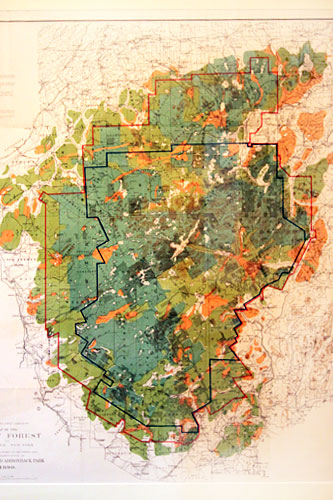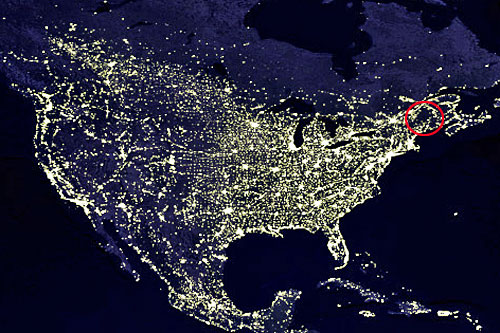From the view deck at Adirondack Museum, Blue Mountain Lake sparkled like a dazzling sapphire surrounded by emerald forests. I contemplated the distant dusky blue mountains and tried grasp that every bit of the vista spread before me had at one time been covered by a shallow inland sea.

The Adirondack Mountains began to take their current shape about 10,000 years ago during the last ice age, when lake waters froze into glaciers and exposed the seafloor. Erosion gradually removed the soft sediments, uncovering slightly tilted crustal rock that had been contorted and folded by eons of plate tectonics. Glaciers transformed this exposed Adirondack dome, wearing away bedrock and gouging river valleys as they melted, leaving behind more than 30,000 miles of streams and brooks, 1,500 miles of rivers, and 2,759 lakes and ponds. In a final act of whimsy, the receding glaciers deposited isolated boulders that today dot the mountains like giant marbles cast aside by a long-lost race of giants.
These mountains may be some of the oldest in the world but the human history within them is remarkably young. Though Indians hunted in the Adirondacks they developed no settlements. Even homesteaders heading for the American west skipped over the forbidding, rugged terrain with its brutal winters. Just getting there required a monumental effort; it took a minimum of 15 days to travel by sloop, keelboat and horse from New York City to the Old Forge area. By 1800, there were only 11,000 permanent residents in the area, most of whom worked at 17 sawmills and three iron mines.
Can’t view the above slide show about the Adirondack Museum and The Wild Center? Click here.
I wandered through the museum, learning about the life of the loggers, miners, and naturalists who finally brought the area to the attention to the general public in the mid 1850’s. As stagecoaches, trains, and cars made the Adirondacks more accessible, it became fashionable to spend time in the wilderness. Hotels sprung up, tourists flocked to the area, and wealthy east coast families built elaborate lakefront summer camps. Before long there was strong sentiment to restrict activities of the logging companies that had clear-cut old growth forests, leaving the mountains denuded. The New York State Legislature finally created Adirondack Park in 1892 and environmentalists successfully amended the State constitution to require lands owned by the State be “forever kept as wild forest.”

For more than a century, Adirondack Park has been one of the oldest conservation experiments in the world. The 3.5 million acres of private land contained within the six-million acre Park require a delicate balancing act between saving a wilderness and meeting the needs of the 130,000 permanent residents and eight million tourists that visit each year. Though reforestation of the Park has been successful, environmentalists point to the 500 Adirondack lakes and ponds that no longer support native plants and aquatic wildlife due to acid rain as proof that limited human activity should be allowed. But as traditional industries have declined (only 40 sawmills, three pulp/paper mills, one operating mine remain in the Park), unemployment has risen and wages have decreased, leaving residents feeling that their needs are ignored in favor of environmental concerns.

That evening I sat down at my computer and pulled up a night satellite photo of New York on the NASA website. Bright lights blazed up and down the Eastern Seaboard, marking the centers of population, but one spot in upstate New York was devoid of lights – Adirondack Park. I stepped outside and contemplated an onyx sky brimming with stars. On that moonless night, blissfully free from light pollution, the Milky Way painted a swath so brilliant I needed no flashlight to navigate. There may never be concurrence on what constitutes “forever wild” in New York State, but for my money, they’re doing a pretty good job.
Visiting Adirondack Museum:
Adirondack Museum brings to life the history of man’s relationship to the land and environment within Adirondack Park. Exhibits include the various modes of transportation that shaped the development of the Adirondacks, the logging industry, farming, settlement and community life, outdoor recreation, travel and tourism, and fine arts, among others. An authentic early school house, inn, blacksmith shop and Adirondack cottage have also been moved to the grounds and restored, and hands-on workshops in paddle carving and boat building are available. The museum’s 22 indoor and outdoor exhibit spaces are located on a 32-acre campus, and seeing everything can easily take the better part of a day. The Lake View Cafe offers fresh soups, salads, sandwiches and hot entrees for those who wish to spend the day. Admission is $18 for adults ($16 for seniors), $12 for teens ages 13-17, and $6 for children ages 6-12. Children 5 and under are free, as are active members of the military. Adirondack Museum, located in the community of Blue Mountain Lake, is one of the finest regional museums in the country and is an excellent outing for anyone planning a visit to the Adirondacks.
Adirondack Park kindly hosted the author’s visit to the Adirondacks in upstate New York. However, the receipt and acceptance of complimentary items/services received will never influence the content, topics, or posts in this blog. I write the truth, the whole truth, and nothing but the truth.

The area you have circled is actually in north west Maine. If you follow the western point of Long Island north, that is pretty much the west boundry of NYS. There is still a blacked out area in the Adirondacks, and believe me, it is truly dark when the sun goes down. i live in the western part of the Adirondack park in Lewis county.
You are absolutely right Alex, and how embarrassed am I! The Adirondacks are the other dark spot, just to the left and a bit south.
I cannot believe how little of the US map is free from lights and light pollution. I’m quite surprised, especially by the coverage in the middle of the map.
Hi,
I am glad to discover your blog. You are right to enjoy; life is too short…
I will be returning to read your other posts about the Adrionack region. The one & only time I was there was while I was on a Montreal bound Greyhound bus… What I saw (then in late September) looked lovely.
Barbara at http://photodreamin.wordpress.com/